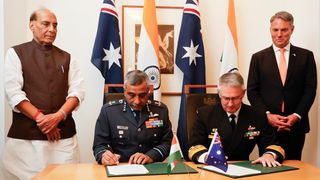Researchers contributing to the Alliance 21 Trade and Investment theme and theme leader Andrew Stoler held a two-day workshop at the East-West Center in Honolulu over. Participating in the workshop were Roger Farrell, Maryanne Kelton, John Ravenhill, Joanna Shelton, Peter Gallagher and Mark Beeson. East-West Center President Charles Morrison sat in on several of the workshop sessions. Participants are in general agreement that the workshop, which provided a sounding board for their ideas and research directions to date, contributed importantly to their work in the next phase aimed at producing final conference papers under the theme.
In the first part of the workshop, the Australia-United States Free Trade Agreement (AUSFTA) and the bilateral economic relationship more generally were examined by Roger Farrell (from a USA perspective) and Maryanne Kelton (from an Australian standpoint). As they work toward finalizing their research, both will focus on trends in bilateral trade and investment since the AUSFTA’s entry into force and the degree to which rising investment flows but reduced trade intensity for merchandise trade might be attributed to developments ranging from Australia’s growing resource-based relationship with China and the relatively weak performance of the American economy to the relative value of the Australian dollar.
John Ravenhill and Joanna Shelton discussed the evolving content and architecture of the Trans-Pacific Partnership (TPP) negotiations and what these negotiations and an eventual agreement might mean both for the bilateral relationship and American and Australian relations with other Asia-Pacific neighbours. Both researchers and workshop participants recognized that a deeper examination of TPP implications would be made more complicated by the fact that the negotiations are relatively non-transparent and an agreement is unlikely to be reached within the timeframe of the initial phase of the Alliance 21 project. It was generally agreed that key questions would be whether the United States agreed to revisit earlier market access agreements in pre-existing FTAs and the extent to which the TPP is truly a “21st Century” trade agreement where important progress might be realized on significant behind-the border measures.
The role of investment, value chains and expected demographic and productivity developments were discussed by Peter Gallagher in connection with his research into the expected future competitiveness of firms based in Australia, the USA, India and China. The workshop examined the implications of production fragmentation, the relative importance of wage rates, factors influencing productivity and the rise of “additive manufacturing” (3-D printing) for the relative competitiveness of firms in the Asia-Pacific region in 2030. Discussion in this part of the workshop also drew attention to the inadequacies of current statistics on international trade and the need for more information that might be analyzed on a “value-added” basis.
The final session of the workshop was devoted to a discussion led by Mark Beeson of Australia’s place in the Asia-Pacific regional economy. Most agreed that it no longer makes much sense to think about this issue in terms of discrete, self-contained national economies, especially given the very high levels of foreign direct investment in a number of key Australian industrial sectors. The growing importance of the Chinese and other Asian markets for Australia and the two-speed Australian economy are important factors. On the bilateral relationship with China, there are obvious advantages for both countries but the benefits are unevenly distributed and raise the limits of “methodological nationalism” when trying to understand complex relationships.
Researchers participating in the workshop agreed to finalize their contributions by mid-September at the latest and to subject them to a “peer review” within the group.







